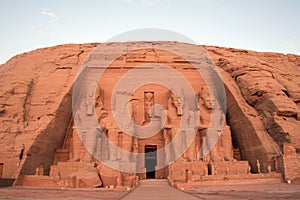- Stock Photography: ABU SIMBEL - TEMPLE OF KING RAMESSES II by Imagineimages
- Price: 1$
- Size Facebook: 1702 x 630 px
- Size Twitter: 1500 x 500 px
- Size LinkedIn: 1128 x 191 px
More Facebook, Twitter and LinkedIn Cover Photos
Cover photo info
- Photo title: Abu Simbel - Temple of King Ramesses II
- Author: Imagineimages
- Cover photo description:
- Abu Simbel is an archaeological site comprising two massive rock temples in southern Egypt on the western bank of Lake Nasser about 290 km southwest of Aswan. It is part of the UNESCO World Heritage Site known as the Nubian Monuments, which run from Abu Simbel downriver to Philae (near Aswan). The twin temples were originally carved out of the mountainside during the reign of Pharaoh Ramesses II in the 13th century BC, as a lasting monument to himself and his queen Nefertari, to commemorate his alleged victory at the Battle of Kadesh, and to intimidate his Nubian neighbours. However, the complex was relocated in its entirety in the 1960s, on an artificial hill made from a domed structure, high above the Aswan dam reservoir. The relocation of the temples was necessary to avoid being submerged during the creation of Lake Nasser, the massive artificial water reservoir formed after the building of the Aswan dam on the Nile River. Abu Simbel remains one of Egypt's top tourist attractions. Construction of the temple complex started in approximately 1284 BC and lasted for circa 20 years, until 1264 BC. Known as the Temple of Ramesses, beloved by Amun, it was one of six rock temples erected in Nubia during the long reign of Ramesses. Their purpose was to impress Egypt's southern neighbours, and also to reinforce the status of Egyptian religion in the region.
- Image ID:8088883
- Views:1765
- Downloads:17
Keywords for Facebook, Twitter and LinkedIn timeline photos
abu
africa
amazing
amun
ancient
archaeology
architecture
astonishing
aswan
attraction
attractive
beautiful
breathtaking
civilisation
column
complex
culture
dazzling
distinctive
dramatic
egypt
egyptian
exceptional
extravagant
glowing
gods
gorgeous
grand
great
hieroglyphics
hieroglyphs
historical
horus
image
impressive
incredible
karnak
kings
luxor
magnificent
monument
monuments
nefertari
pharaoh
photo
photograph
photography
pillar
pretty
queens
ramesses
religious
remarkable
royalty
ruin
ruins
sand
sculpture
sculptures
simbel
site
sphinx
sphinxes
statue
statues
stone
striking
stunning
temple
tomb
tourism
tourist
travel
tremendous
unique
unusual
vibrant
vivid














